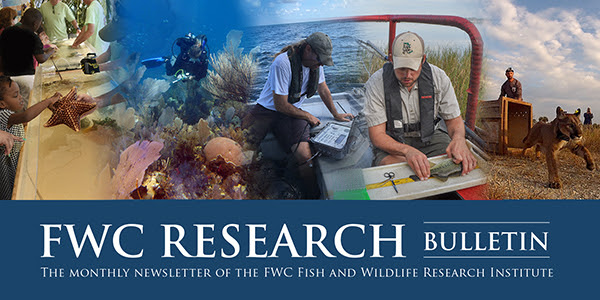|

|

New Human Bear Interaction Research
In recent decades, human-bear interactions (HBI) have become more common in residential areas throughout North America. Florida, where both the human and Florida black bear (U. americanus floridanus) populations have increased substantially since the early 2000s, is no exception. While public perception of bears may be generally positive, conflicts tend to arise as bears make their way into areas with higher human activity, such as suburban neighborhoods. To learn more about these interactions and how they affect public perception, FWC researchers conducted surveys among residents in two urban neighborhoods with ordinances that mandate anthropogenic (human) food sources are properly secured.
Our researchers surveyed residents in the neighborhoods before and after they received bear-resistant garbage cans (BRC) and found that a combination of preventative measures and BRC usage reduced HBI by 54%, and completely eliminated incidents where bears accessed garbage. Additionally, analysis of calls to the FWC regarding HBIs showed a decline over the five years following ordinance implementation compared to the preceding five years. Consequently, residents reported feeling safer and spending more time outdoors in their neighborhood with less fear of a negative human-bear interaction. FWC relies on peer-reviewed science for its management; to access this full publication click here. FWC photo.

Suwannee Snappers!
Our partners at the University of Florida (UF) were recently contacted by a citizen, who lives along a tributary of the Santa Fe River, regarding Suwannee alligator snapping turtles that nested in his yard on April 1st and 10th. Our team, led by FWRI biologist Kevin Enge and Travis Thomas from UF, helped describe Suwannee alligator snappers (Macrochelys suwanniensis) as a new species in 2014, and have continued their research under a State Wildlife Grant. Their recent efforts have focused on studying Suwannee alligator snapper nesting by locating nest sites, which is done by attaching GPS tags to females and recapturing them later to download movement data. In this case, Greg (the citizen) made it easy on our team and gave them a unique opportunity to learn more thanks to this call! Greg then placed a protective cage over the nest site to prevent predators from digging up the eggs until our team of biologists arrived, which included Jerry Johnston, Cody Godwin (Santa Fe College), and Shea Husband (UF).
The team arrived to excavate the first nest on April 8th to determine the number of eggs laid and to remove them for safe keeping. After about an hour of carefully digging through pine roots, the first egg was finally uncovered. The team recovered 26 eggs that resembled ping pong balls from the nest. Some team members returned on the 11th to excavate the second nest that contained 38 eggs. Thankfully, these eggs were much easier to find because the nest was poorly covered – a sign the animal was likely interrupted while nesting.
While it may have taken a while for our biologists to uncover these eggs, a predator who is not behaving as carefully can rip up and ravage the nest in mere minutes. Usually, 80-90% of turtle nests are depredated by raccoons, armadillos, or other predators, but these eggs will be incubated at an FWC facility for about the next 100 days. Once they hatch, our team will collect data on the hatchlings and release them into the stream. Very little is known about this species’ hatchlings and eggs, and only a few nests have ever been found.
This project was conducted under proper state and federal permits.
New on MyFWC.com/Research
We hope you enjoy these articles that have been recently added/updated on our website:
Red Tide Current Status
Red Tide-Related Hotlines and Information Sources
2024 Manatee Mortalities
Annual Rescue Summaries [Manatee]
At-Sea Observer Survey
Florida Keys Abnormal Fish Behavior Event 2023 - Present
HAB Publications
New Publications
Stone Crab Catch Data
Panhandle Scallop Sitters
Status and Trends Report
Field Work Inspires Manatee Photo-identification Interns
Our Mission
Through effective research and technical knowledge, we provide
timely information and guidance to protect, conserve, and manage
Florida's fish and wildlife resources.




No comments:
Post a Comment